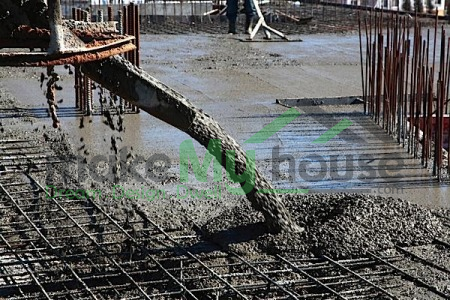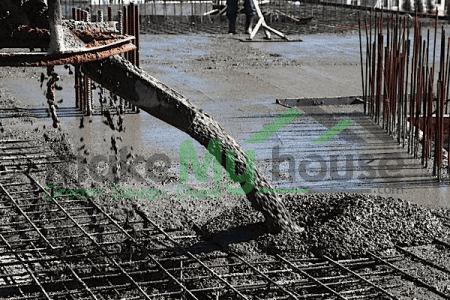Gray Cement
In general ‘Cement’ means Gray Ordinary Portland Cement which is used for general purposes in construction. Cement is one of the most important raw materials used in buildings as the strength of any construction work depends on the quality of cement. The gray cement should be factory-manufactured by a reputed manufacturer. It must not be from a local plant manufacturer. It is properly packed from the factory, not hand packed locally. While taking a supply of gray cement, the manufacturing date, grade, and type should be checked. The cement should not be more than six weeks old from the date of manufacturing.
Types of gray cement
According to chemical properties gray cement can be classified as follows.
- Ordinary Portland cement (for general use)
- Rapid-hardening Portland cement (where high early strength is required)
- Low-heat Portland cement (in mass concrete for dam etc.)

Manufacturing of gray cement
All types of cement like Ordinary Portland Cement, Rapid-hardening Portland cement, or Low heat Portland cement are manufactured by intimately mixing Calcareous, Argillaceous and Silica, and Alumina or Iron Oxide bearing materials, which are burnt at clinkering temperature and are ground to produce gray cement, complying with specifications. No material except Gypsum Water or both should be added after burning.
Specifications of gray cement
Fineness
There are following two methods to check the fineness of Portland cement.
- Method 1: After sieving, the cement on IS test Sieve No.9 (B.S. Sieve No 170) should not exceed 10% in the case of Ordinary Portland Cement.
- Method 2: Specific surface by Air Permeability Method should not be less than 2150 sq. cm/ kg in the case of Ordinary Portland Cement
Soundness
Alternatively, autoclave expansion should not be more than 0.5% when tested according to IS 269 of 1989.
Setting time
Setting time of any type or any grade of cement when tested by the Vicat apparatus method described in IS: 4031 should confirm the following requirement.
- Initial setting time Not less than 30 minutes
- Final setting time: Not more than 600 minutes i.e. 10 hours
Compressive Strength
After 28 days compressive strength of cement concrete mix for various types of cement concrete mix is following.
Compressive strength of cement concrete mix
| S. NO. | Type of Mix | Ratio of Mix | Compressive strength |
| 1. | M 10 | 1:3:6 | 100 kg. Per cm square |
| 2. | M 15 | 1:2:4 | 150 kg. Per cm square |
| 3. | M 20 | 1:1.5:3 | 200 kg. Per cm square |
Note: Cement concrete cubes filled in above mentioned cement ratios should be tested after curing for 7 days and the strength of cement concrete should not be less than 70%.
General guidelines for gray cement
Cement is the most important raw material used in the construction of a building. You can ensure the quality of ‘Cement’ by following guidelines.
- The cement bag bears the date of manufacturing
- One cement bag has 50 Kg. weights
- Cement bags are not hand-stitched
- The consignment must have an identification mark on the package
- Cement is packed in bags of synthetic jute or polypropylene bags
- Factory-manufactured instead of plant manufactured
- Bears manufacturer’s name or his trademark, grade, and type of cement
- Not older than six weeks from the date of manufacturing
- Not partially set due to moisture or have small lumps in bags
- Not pressed or have lumps due to high pressure of stack, having more than 10 to 12 bags
- The bags are not torn by side and stitched in later
Precautions while transporting cement
- Carry bags in clean vehicle which is not dustier or on earth etc. as it reduces the strength of cement.
- Take cement bags under covered Polythene or ‘Tarpaulin’ during monsoon season.
- Labor should not tear bags while loading and unloading cement bags.
Precautions while stacking/storing gray cement
- Store cement in a moist-proof area otherwise the quality of the cement will be affected
- Stack cement bags in dry, leak-proof, and moisture-proof shed/fumes
- Place cement bags on dry brick floors, wooden crates, or planks
- Don’t place cement bags on the earth in any case
- Don’t make a stack of bags higher than 10 bags to avoid lumps under pressure
- Don’t stack up cement bags with outer walls to protect them from dampness
- Pile up cement bags from different manufacturers separately
- Make use of cement on a first come first serve basis
- Cover cement bags with polythene during the monsoon season
- Keep cement bags close to each other to reduce air circulation
Caution for storage/stacking
- When construction work is assigned to a contractor, make sure he takes proper care of the cement. Many times contractors do not take care of proper storage of cement at the site as it costs them labor and money. This results in a reduction in the strength of cement as shown in the table below.
- In some cases, it is observed that after laying the RCC slab on some parts of the building, the contractor dismantles his temporary store at the site and places cement bags on the ground floor of the building which is under construction. It is not good as cement bags may draw moisture from the floor and walls of the new building and result in a reduction of strength in cement because the new building is wet due to construction work in progress.
Reduction in cement strength due to storage
| S. No | Storage Period | Reduction in Strength |
| 1. | Fresh cement | Nil |
| 2. | Three months old | 20% |
| 3. | Six months old | 30% |
| 4. | 12 Months old | 40% |
| 5. | 24 Months old | 50% |
Caution for cement strength
- Cement retards in hardening and reduces strength due to the absorption of moisture during storage.
- It is okay for cement to absorb up to 1.2% moisture as this level of moisture is acceptable but if absorption exceeds 5%, the cement is destroyed for all practical purposes.
- Different types of cement should not be mixed while using them for construction purposes.












2 thoughts on “Purchasing Cement Guidelines-1”